- Home >
- Services >
- Access to Knowledge >
- Trend Monitor >
- Domain of Application >
- Trend snippet: Organizations are spending more on prevention versus being reactive in their cybersecurity posture
Trends in Security Information
The HSD Trendmonitor is designed to provide access to relevant content on various subjects in the safety and security domain, to identify relevant developments and to connect knowledge and organisations. The safety and security domain encompasses a vast number of subjects. Four relevant taxonomies (type of threat or opportunity, victim, source of threat and domain of application) have been constructed in order to visualize all of these subjects. The taxonomies and related category descriptions have been carefully composed according to other taxonomies, European and international standards and our own expertise.
In order to identify safety and security related trends, relevant reports and HSD news articles are continuously scanned, analysed and classified by hand according to the four taxonomies. This results in a wide array of observations, which we call ‘Trend Snippets’. Multiple Trend Snippets combined can provide insights into safety and security trends. The size of the circles shows the relative weight of the topic, the filters can be used to further select the most relevant content for you. If you have an addition, question or remark, drop us a line at info@securitydelta.nl.
visible on larger screens only
Please expand your browser window.
Or enjoy this interactive application on your desktop or laptop.
Organizations are spending more on prevention versus being reactive in their cybersecurity posture
• The category Identify saw a rise in expenditures from 21% to 27% from 2019 to 2020
• Protect and Detect remained basically the same at 25% and 18% respectively
• Spending in the Respond and Recover categories declined somewhat in the same timeframe to 15% and 14% respectively
Enterprises are always trying to find the right balance between being proactive and being responsive and resilient, and that pendulum swings back and forth every year. Last year, organizations may have been concentrating their efforts on the basics (asset inventory, discovery, etc.). And theoretically, if you spend right on Identify, Protect and Detect up front, you shouldn't need to spend as much on Respond and Recover, as they aren’t needed as often.
In exploring how security budgets are spent, we surveyed our respondents on five categories (Identify, Protect, Detect, Respond, and Recover) that describe the lifecycle of cybersecurity defense and breach management:
• The category Identify saw a rise in expenditures from 21% to 27% from 2019 to 2020
• Protect and Detect remained basically the same at 25% and 18% respectively
• Spending in the Respond and Recover categories declined somewhat in the same timeframe to 15% and 14% respectively
Enterprises are always trying to find the right balance between being proactive and being responsive and resilient, and that pendulum swings back and forth every year. Last year, organizations may have been concentrating their efforts on the basics (asset inventory, discovery, etc.). And theoretically, if you spend right on Identify, Protect and Detect up front, you shouldn't need to spend as much on Respond and Recover, as they aren’t needed as often.






